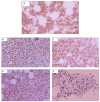Immunophenotypic expression profile of multiple myeloma cases at a tertiary hospital in Nairobi Kenya
- PMID: 37250623
- PMCID: PMC10213391
- DOI: 10.3389/fmed.2023.1177775
Immunophenotypic expression profile of multiple myeloma cases at a tertiary hospital in Nairobi Kenya
Abstract
Introduction: Multiple myeloma (MM) is a plasma cell neoplasm that constitutes 10-15% of all hematopoietic neoplasms. Kenya is placed among the top five African countries for MM incidence and MM-related mortality. Prior studies have suggested that the aberrant expression of Cyclin D1, CD56, CD117 and Ki-67 on neoplastic plasma cells is useful in disease prognostication. The prevalence and significance of expression of these markers in a cohort of MM cases in Kenya has not been studied previously.
Methods: A retrospective cross-sectional study was carried out at the Aga Khan University Hospital, Nairobi. The study population included 83 MM cases with available trephine blocks archived between 1st of January 2009 and 31st of March 2020. Immunohistochemical expression of Cyclin D1, CD56, CD117, and Ki-67 was analyzed and scored. The biomarkers were described using frequencies based on the positive and negative results. Fisher's exact test was used to determine the association between the immunophenotypic markers and categorical variables.
Results: Of the 83 selected cases, expression of Cyclin D1, CD56, CD117 and Ki-67 was identified in 28.9, 34.9, 7.2, and 50.6%, respectively. Cyclin D1 positivity was significantly associated with hypercalcemia. Absence of CD117 expression was noted to be associated with adverse risk parameters including an IgA isotype or light chain disease, International Staging System (ISS) stage III disease, abnormal baseline serum free light chains (sFLC) and a high plasma cell burden.
Conclusion: Cyclin D1 expression was congruent with previously reported studies. The frequency of CD56 and CD117 expression was lower than previously reported. This may be due to differences in disease biology between the study populations. Approximately half of cases were Ki-67 positive. Our data showed limited associations between the expression of studied markers and clinicopathologic variables. However, this could be attributed to the small study sample size. We would recommend further characterization of the disease in a larger prospective study with the inclusion of survival outcomes and cytogenetic studies.
Keywords: CD117; CD56; Cyclin D1; Kenya; Ki-67; Multiple Myeloma; immunophenotype.
Copyright © 2023 Mengich, Rajput, Malkit, Moloo, Kagotho, Lalani and Mwirigi.
Conflict of interest statement
The authors declare that the research was conducted in the absence of any commercial or financial relationships that could be construed as a potential conflict of interest.
Figures


Similar articles
-
Evaluation of CD56 and CD117 Double-Positivity as a Predictor of Poor Prognosis in Multiple Myeloma Patients: A Retrospective Analysis.Turk J Haematol. 2024 Dec 2;41(4):236-245. doi: 10.4274/tjh.galenos.2024.2024.0149. Epub 2024 Oct 8. Turk J Haematol. 2024. PMID: 39377029 Free PMC article.
-
CD56 Expression Is an Important Prognostic Factor in Multiple Myeloma Even with Bortezomib Induction.Acta Haematol. 2018;139(4):228-234. doi: 10.1159/000489483. Epub 2018 Jun 19. Acta Haematol. 2018. PMID: 29920491
-
[Expression of CD56 and CD19 in Patients with Newly Diagnosed Multiple Myeloma and Their Relationship with Karyotypes and Prognosis].Zhongguo Shi Yan Xue Ye Xue Za Zhi. 2016 Aug;24(4):1071-8. doi: 10.7534/j.issn.1009-2137.2016.04.021. Zhongguo Shi Yan Xue Ye Xue Za Zhi. 2016. PMID: 27531777 Chinese.
-
Immunophenotype of neoplastic plasma cells in AL amyloidosis.J Clin Pathol. 2009 Aug;62(8):724-30. doi: 10.1136/jcp.2009.065474. J Clin Pathol. 2009. PMID: 19638544
-
The Assessment of CD56 and CD117 Expressions at the Time of the Diagnosis in Multiple Myeloma Patients.Turk J Haematol. 2017 Aug 2;34(3):226-232. doi: 10.4274/tjh.2016.0394. Epub 2017 Mar 8. Turk J Haematol. 2017. PMID: 28270374 Free PMC article. Clinical Trial.
Cited by
-
Monoclonal Gammopathies in Africa.Clin Lymphoma Myeloma Leuk. 2025 Sep;25(9):e696-e703.e2. doi: 10.1016/j.clml.2025.05.023. Epub 2025 May 31. Clin Lymphoma Myeloma Leuk. 2025. PMID: 40579286 Review.
-
Evaluation of CD56 and CD117 Double-Positivity as a Predictor of Poor Prognosis in Multiple Myeloma Patients: A Retrospective Analysis.Turk J Haematol. 2024 Dec 2;41(4):236-245. doi: 10.4274/tjh.galenos.2024.2024.0149. Epub 2024 Oct 8. Turk J Haematol. 2024. PMID: 39377029 Free PMC article.
References
-
- Swerdlow SH, Campo E, Harris NL, Jaffe ES, Pileri SA, Stein H, et al.. (eds.). WHO Classification of Tumours of Haematopietic and Lymphoid tissues. Revised 4th ed. Lyon: IARC; (2017). 243–8.
-
- Kiraka G, Etabale M, Riyat M. A review of 74 patients with newly diagnosed multiple myeloma at a tertiary referral hospital in Nairobi. Kenya J Africain du Cancer. (2014) 6:70–4. doi: 10.1007/s12558-013-0294-5 - DOI
LinkOut - more resources
Full Text Sources
Research Materials
Miscellaneous

